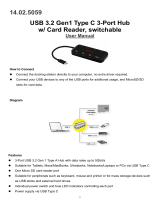
MTX-H15 UMTS-HSDPA terminal modem http://www.matrix.es
MTX-H15 User Manual V.2.0 Pag. 3
Preliminary. Subject to change without prior notice
1. INTRODUCTION 5
1.1 Description...............................................................................................................................5
1.2 Highlights.................................................................................................................................6
1.3 Main Features and Services .......................................................................................................7
1.3.1 Types of Mobile Station..................................................................................................................................7
1.3.2 Short Message Service....................................................................................................................................8
1.3.3 Voice Calls .....................................................................................................................................................8
1.3.4 Data................................................................................................................................................................9
1.3.6 OPERATION MODES....................................................................................................................................9
1.3.7 SIM Card......................................................................................................................................................11
1.4 Precautions ............................................................................................................................ 11
2. MECHANICAL DESCRIPTION..........................................................................................................................11
2.1 Overview ............................................................................................................................... 11
2.2. Dimensions ........................................................................................................................... 12
3. ELECTRICAL DESCRIPTION............................................................................................................................13
3.1 Power Connector .................................................................................................................... 13
3.2 Audio Connector ..................................................................................................................... 14
3.3 Mini USB Connector ................................................................................................................ 15
3.4 Antenna Connector ................................................................................................................. 16
3.5. SIM card reader..................................................................................................................... 16
3.6 Real Time Clock...................................................................................................................... 17
3.7. Software Updates .................................................................................................................. 18
4. OPERATION...........................................................................................................................................................19
4.1 Switching On the Modem......................................................................................................... 19
4.2 Switching Off the Modem ........................................................................................................ 19
4.3 Operating States/LED.............................................................................................................. 19
5. HC15 AT COMMAND INTERPRETER..............................................................................................................20
6 SAFETY AND PRODUCT CARE..........................................................................................................................21
6.1. Safety instructions ................................................................................................................. 21
6.2. General precautions ............................................................................................................... 21
6.3. SIM card precautions ............................................................................................................. 21
6.4. Antenna precautions .............................................................................................................. 22
6.5. Radio Frequency (RF) exposure and SAR ................................................................................. 22
6.6. Personal Medical Devices........................................................................................................ 22
7. INSTALLATION OF THE MODEM ...................................................................................................................23
7.1 Where to install the modem..................................................................................................... 23
7.1.1 Environmental conditions.............................................................................................................................23
7.1.2 Signal strength..............................................................................................................................................23
7.1.3 Connections of components to MTX-H15 Terminal .....................................................................................23
7.1.4 Network and Subscription ............................................................................................................................23
7.2 How to install the modem........................................................................................................ 23
7.2.1 Power supply................................................................................................................................................23
7.2.2 Securing the modem .....................................................................................................................................24
7.3 Antenna................................................................................................................................. 24
7.3.1 General.........................................................................................................................................................24
7.3.2 Antenna type.................................................................................................................................................24
7.3.3 Antenna placement .......................................................................................................................................24
7.3.4 The antenna cable.........................................................................................................................................24
7.3.5 Possible communications disturbances........................................................................................................25
8. ACCESSORIES.......................................................................................................................................................26
8.1. POWER SUPPLY..................................................................................................................... 26
8.1.1 AC Power Adaptor .......................................................................................................................................26
8.1.2 DC cable.......................................................................................................................................................26
8.2. ANTENNAS............................................................................................................................ 27





















